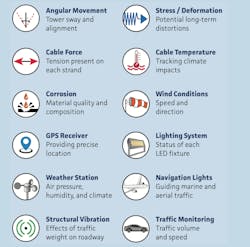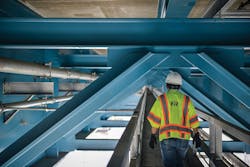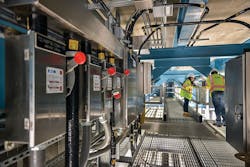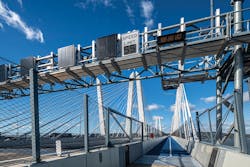Smart systems on new Cuomo Bridge can adapt and keep traffic moving
Drivers may not know it, but those passing over the new Governor Mario M. Cuomo Bridge in New York are experiencing one of the smartest bridges ever built.
The new Cuomo Bridge is a great example of a major structure delivered with advanced technologies and systems, including structural health monitoring (SHM), traffic management, lighting, all-electronic toll collection (AETC), building information modeling (BIM), and asset management.
The 3.1-mile crossing of the Hudson River just north of New York City is massive—over 30 lane-miles of roadway on parallel dual structures, including eight general traffic lanes, dedicated bus lanes, and a shared-use pedestrian/bike path on the northern span. Tappan Zee Constructors, the design-builder, completed the project this past summer and handed over operations and maintenance to the bridge owner, the New York State Thruway Authority (NYSTA).
Systems are not usually the first thing we talk about when admiring a signature bridge, but they are vital to safe and efficient operation. Some are publicly visible, e.g., the traffic management, roadway lighting, and tolling systems. Others, such as security systems and management tools like structural health monitoring, are behind the scenes. Some, such as BIM, are used throughout design, construction, and ultimately into operation and asset management.
Today’s infrastructure must be designed not just to last, but also to adapt to conditions and alert the owner when problems occur. With a design service life of 100 years, NYSTA is relying on these advanced technology systems to help them make informed decisions on maintenance and traffic operations.
Real-Time Decision Support
One of the largest and most comprehensive structural health monitoring systems in the country lets maintenance staff monitor performance of the structure on a real-time basis. More than 300 sensors measure the temperature, strain, and fatigue on the cables and joint movements, and normal corrosion in the concrete and on the deck. As a result, operators can better understand and track how the bridge is aging and reacting as loads are applied and seasonal temperature changes occur.
The system is intelligent, sensing when a trigger event is occurring, such as seismic or ship impact, and sending an email to alert the bridge operator. Data from sensors along the length of the bridge can be compared and analyzed to show how various components react during different trigger events, synchronizing reports from all sensors to the same time-stamp down to the millisecond. In addition to analyzing trigger event periods, the system can compare the performance of the structure year over year to improve maintenance planning by reporting on key metrics such as bearing life, expansion joint life, and corrosion, which in turn leads to quicker and more robust ROI.
Adaptability & Improved Safety
The bridge’s ITS works alongside the SHM system, receiving data from SHM sensors such as temperature and wind speed, which helps operators make informed decisions about traffic management. Hundreds of preprogrammed algorithms let operators change traffic patterns and speed limits at the click of a button, relaying information to passing motorists via digital highway signage. These signs inform motorists of incidents and direct them away from closed lanes, helping drivers avoid last-second lane shifts and reducing the potential for other incidents. During winter months, the state-of-the-art system monitors pavement conditions in real-time so roadway treatment and snow removal can function more efficiently. These enhancements have been shown to minimize delays to motorists, allowing the public to get the most out of its investment.
Future-Prepared
With technology evolving rapidly, it is important that any system applied to a structure with a design life as long as the Cuomo Bridge’s be capable of being upgraded easily and expanded in the future without the need for additional infrastructure or large costs. One example is connected vehicle technology wherein devices inside cars, trucks, and buses will communicate with each other to be aware of other nearby vehicles and be capable of receiving notifications. The Cuomo Bridge infrastructure systems were designed with this future technology in mind—ready for the additional hardware, power, and data bandwidth requirements that come with operating a connected vehicle network.
The focus on efficiency and monitoring extends to roadway lighting, all from energy-efficient LED luminaires. Until about 10 years ago, a typical highway or bridge would have used high-pressure sodium or mercury vapor lighting fixtures with wattage around 250-300W per roadway light. By using LED lighting, the typical wattage on a luminaire is about half that—100-150W each. As a state-of-the-art innovation, a wireless repeater node was added to the top of each roadway fixture so all roadway lights can talk to each adjacent fixture and send real-time signals back to a remote operator’s console. Typical signals would include fixture status, dimming setpoint, maintenance required, end-of-life estimate and schedule, all of which allows staff to program the lights remotely, proactively schedule maintenance activities, and have real-time trending of energy usage.
Like the roadway lighting, aesthetic lighting uses LED fixtures. Over 2,500 aesthetic lights, each individually addressable and connected to a remote operator’s console via the fiber-optic network, illuminate the full height of the approach pier columns, main span cables, and main span towers. The chosen LED system produces over 16 million color combinations and has an estimated life of 100,000 hours. To achieve uniform light distribution across all the columns and towers, each fixture is individually angled and dimmed depending on the height of the column and location from land to make each pier look identical.
The technology, sensors, and energy-efficient equipment allow the operator to maintain and operate the bridge in a safer and more efficient manner than would otherwise be possible. With the sheer quantity of sensors, devices, cabinets, and controllers installed to operate these systems, it was essential to deliver a comprehensive digital asset management system to store operating manuals, maintenance records, as-built drawings, and other pertinent information to assist in the future maintenance of these systems. That is where BIM came in.
An experiment gone right
The NYSTA asked for an as-built crossing database for maintenance and planning as the tool to deliver project documentation such as as-built drawings, mill certifications, inspection reports, operating manuals, construction photos, and more. This plethora of data had to be organized and interconnected so that users across all project tasks have instant access to life-cycle management information.
The first building block of the asset management system was to create the digital model during the design phase. Designers executed this using a highly detailed model of the substructure and superstructure of the bridge, along with modeling to include the catwalks, utilities, signage, and other bridge appurtenances.
The next building block was to connect data to the design model. To enable these data connections, all of the design models were created with information about what they were (girder, pier, deck) and where they were located (unit, span, direction). Because designs were developed with various software, all design models were exported to the open standard format Industry Foundation Class (IFC), which allowed connecting models into a common data environment and linking elements to the hundreds of thousands of pieces of as-built documentation.
When the bridge’s BIM model was being developed, the approach of exporting the model and embedding data using IFC was experimental. At the time, IFC did not yet include bridge elements in the schema. The project became one of the first bridges in the world to use IFC for a full project deliverable, and HDR’s work was recognized with the buildingSMART International Award for Operations and Maintenance using open technology in 2017.
Since then, the AASHTO Committee on Bridges and Structures and the Committee on Design have adopted IFC as the standard 3-D deliverable format for all AASHTO states. A pooled fund project, TPF-5(372) BIM for Bridges and Structures, will now develop IFC deliverables that can specifically represent bridges. Using 3-D models—and IFC specifically—has become a fast-growing trend for bridge projects around the world.
Intelligent, Proactive Maintenance Optimizes Asset Life
Operating and maintaining a facility on the scale of the Cuomo Bridge is an enormous task. Simply knowing what is out there on the river is a challenge—and automating access to maintenance records through the crossing database gives a tremendous productivity boost to operations staff. Bridge maintenance historically has been somewhat reactive—regular inspection shows a problem, engineers dig into plans and past inspection reports and manuals to analyze the problem, and they design and implement a repair.
The smart systems on this bridge—SHM, ITS, and BIM—give operators the power to do intelligent, proactive maintenance. BIM turns data into information. Information is readily available on every element from a girder to a light fixture—plans, as-builts, inspection reports, manuals—along with real-time data on current performance. Not only do staff know what is out there, they can drill down to see trends in the service life of components. If an element is not performing as expected, they can take action proactively to prevent future issues, adjusting maintenance plans and budgets accordingly. In this way, a 100-year design service life can, with optimal maintenance, last much longer.






